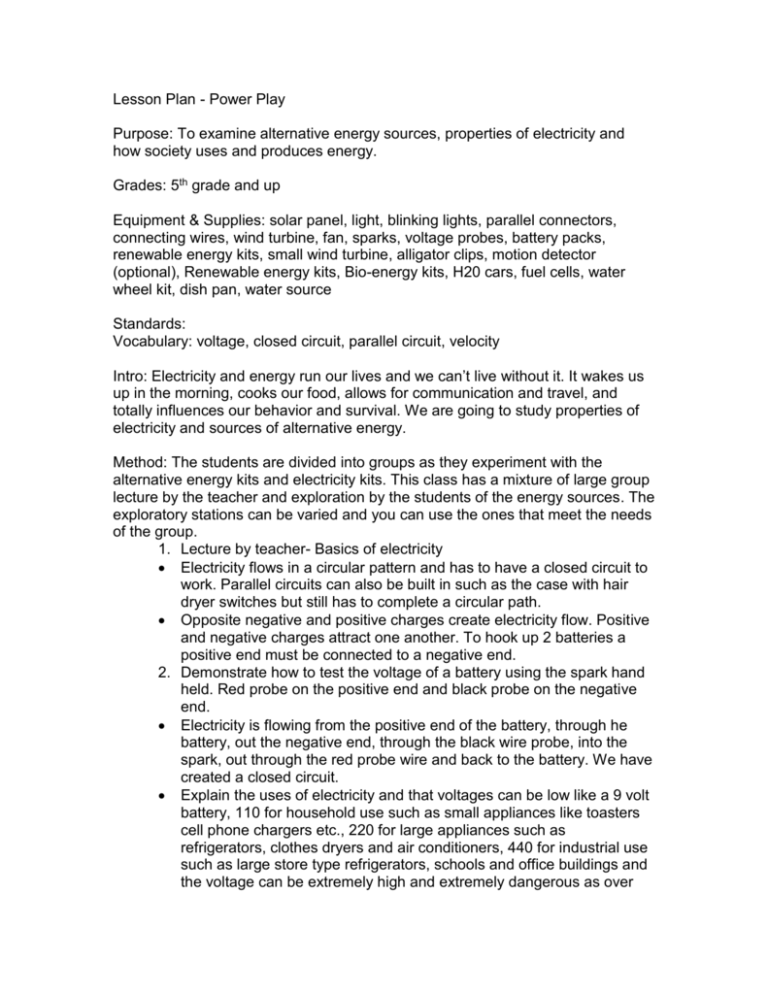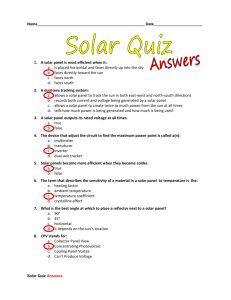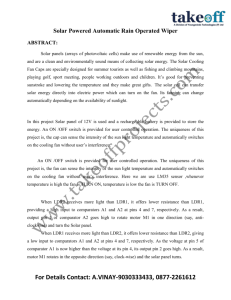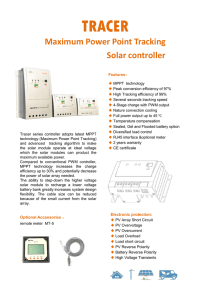Lesson Plan - Power Play
advertisement

Lesson Plan - Power Play Purpose: To examine alternative energy sources, properties of electricity and how society uses and produces energy. Grades: 5th grade and up Equipment & Supplies: solar panel, light, blinking lights, parallel connectors, connecting wires, wind turbine, fan, sparks, voltage probes, battery packs, renewable energy kits, small wind turbine, alligator clips, motion detector (optional), Renewable energy kits, Bio-energy kits, H20 cars, fuel cells, water wheel kit, dish pan, water source Standards: Vocabulary: voltage, closed circuit, parallel circuit, velocity Intro: Electricity and energy run our lives and we can’t live without it. It wakes us up in the morning, cooks our food, allows for communication and travel, and totally influences our behavior and survival. We are going to study properties of electricity and sources of alternative energy. Method: The students are divided into groups as they experiment with the alternative energy kits and electricity kits. This class has a mixture of large group lecture by the teacher and exploration by the students of the energy sources. The exploratory stations can be varied and you can use the ones that meet the needs of the group. 1. Lecture by teacher- Basics of electricity Electricity flows in a circular pattern and has to have a closed circuit to work. Parallel circuits can also be built in such as the case with hair dryer switches but still has to complete a circular path. Opposite negative and positive charges create electricity flow. Positive and negative charges attract one another. To hook up 2 batteries a positive end must be connected to a negative end. 2. Demonstrate how to test the voltage of a battery using the spark hand held. Red probe on the positive end and black probe on the negative end. Electricity is flowing from the positive end of the battery, through he battery, out the negative end, through the black wire probe, into the spark, out through the red probe wire and back to the battery. We have created a closed circuit. Explain the uses of electricity and that voltages can be low like a 9 volt battery, 110 for household use such as small appliances like toasters cell phone chargers etc., 220 for large appliances such as refrigerators, clothes dryers and air conditioners, 440 for industrial use such as large store type refrigerators, schools and office buildings and the voltage can be extremely high and extremely dangerous as over 3. 4. 5. 6. head wires and power plants. Briefly explain how the stations work and what is expected of the students when experimenting with the alternative energy kits. First exploratory station – Wind power. Students will experiment with the large wind turbine. They can change the blades to change the lift and drag of the wind, or change the wind speed and record the voltage produced. Second exploratory station – Solar power. At this station the students use a solar panel to light a display of blinking lights. They can hook up a series of panels and lights to see if they can get them all to work. They can change the angle of the solar panel and measure the voltage produced by the solar panel. Third exploratory station – Small wind fan with a battery pack. The students will note how the battery pack and the fan connect to create a closed circuit. They will hook the red wire to the red connection and the black to black connection. They will note the speed (with the motion detector) and direction of the wind. They can also measure the voltage of the battery pack with the Spark voltage meter and alligator clips. Next the students will reverse the red/black connections and note the wind change and direction. Fourth experimental station – Electrocity. The students will use the computers to play this game. They have 150 turns to build a city with happy population, power, and community recourses. They have to balance green sources with energy production and population needs. They get a grade at the end in 4 categories. 7. Fifth experimental station – Water wheel 8. Sixth experimental station – Bio-energy windmill 9. Seventh experimental station – H20 cars 10. Eighth experimental station – fuel cell Questions: 1. What are the reasons we get a low number on the voltage reader or no reading at all? 2. What happens when you hook a red connection wire to a black connector on the small fan? 3. What happens when you hook a red connection wire to a black connector on the solar panel? 4. What are some practical uses for solar panels? 5. What is the voltage a battery tested? 6. What is the voltage of a combination of batteries? 7. What is the voltage the solar panel produced? Check the voltage of the large windmill Solar panel Small windmill Combinations What are the reasons we get a low number on the voltage reader or no reading at all? What happens when you hook a red connection wire to a black connector on the small fan? What happens when you hook a red connection wire to a black connector on the solar panel? What are some practical uses for solar panels? What is the voltage a battery or batteries tested? What is the voltage the solar panel or solar panels produced? Describe how you built your solar oven? Explain how the solar panel cooked the s’mores? Describe how well the s’mores were cooked?







